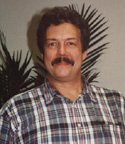

I was born in 1955, (Scorpio), grew up in Colorado with three little sisters and skied a lot, took a brief spin through University of Colorado in Boulder, played at being a stock broker in the Go-Go days of the Denver penny stock market, started a small manufacturing business that made penguins,
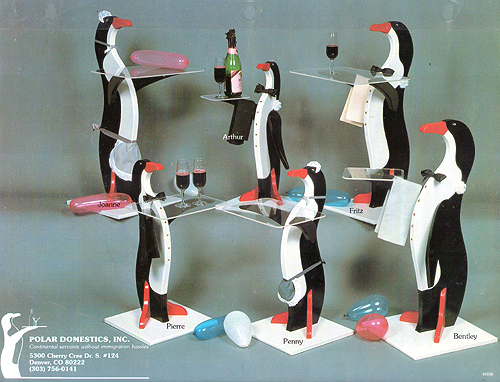
became an uncle, moved to California just in time for the Loma Preata excitement, refined and simplified the business to make a completely unrelated item for the wine / novelty market,
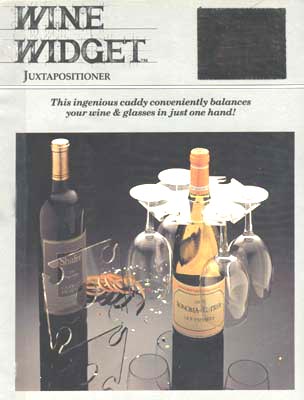
....became an uncle some more, finished at SJSU what I started at CU, got some real interesting jobs and internships before and after graduation, including a real eye-opener as a high school teacher, ultimately wound up being an uncle 6 times over and found uncle-ing to be a wonderful thing indeed, and finally, I am starting another business, -the one that links to this page- and throughout-, Iíve had this lovely antique hole in the water, surrounded by wood, ...

...got
shed of the boat and moved back to Colorado in '06 taught a little and still
make sawdust.
The following is a rather brief and generic resume. If I have given you a PDF password for my curriculum vitae, use it here.
Bill Harvey
2342 Beech Ct. Golden, CO 80401 303-731-9061 WHarvey904@Hotmail.com
EDUCATION:
San Jose State University
June 1997
BS Industrial Technology -Advanced Manufacturing systems
BA General Design -Industrial design emphasis,
Business minor
August 2005
All classes and various computer-user tests necessarily for a California clear credential for single subject (high-school) teacher.
Certified Manufacturing Technologist 1996, (Society of Manufacturing Engineers)
Computer skills include AutoCAD, CADKey, CNC / CIM, html, C / C++, Java Scripts, word processing, spreadsheet, database, and graphic design software applications.
BACKGROUND:
Sept 99 - Present Business owner / Manufacturer This time has been spent improving the profitability of my business and launching a separate manufacturing business, -www.Home-Museum.com- which makes specialized casework for collectors and hobbyists.
Sept '06 - March '08 Teacher The Learning Source I taught intermediate ESL, ABE, and most recently was the math & science half of a two person GED team.
October '01 - June '05 Milpitas Adult Education, Teacher I taught general academics to adult students seeking their GED in both "night school" and Elmwood Correction Facility. I taught all subjects in both environments, but tended to specialize in teaching math in the jail setting. Additionally, I taught "Home Handy Man / Woman" one night a week through most of 2005. I wrote the curriculum for this class, and over the years teaching GED / ABE, I refined, rewrote, and perfected much of the school's adult academic curriculum.
Sept. 98 - Sept 99 Morgan Hill Unified School District Teacher I taught CAD, Computer Design (and developed the curricula for this new course), Introduction to Drafting, and Architecture. Additionally, I developed a new computer lab for the school.
Jan. - August 98 Intel Corporation Engineering Technician Under contract to the Utilities Modeling Group, I was responsible for the accuracy of semiconductor equipment utilities consumption data in a Master Modeling database. I also developed computer based training materials for the Modeling Group's "product."
1996 - 1997 (various firms including Space Systems Loral, IPac Corp. and Applied Materials Corp.) Temporary and Contract Worker during completion of schooling. Mechanical fabrication, satellite mockup, model building, facilities planning, AutoCAD support for factory expansion, materials coordination, and various documentation assignments.
1987 -present Self-employed Small Manufacturer All phases of design and planning leading to profitable in-house manufacturing of two product lines (one for wholesale only, and one for wholesale and retail), including:
1983 - 1994 Self-employed General Contractor, Carpenter Completed all phases of several small design/build projects including preparing new designs to reflect customers wishes and needs.
PERSONAL:
Design portfolio available upon request
WEST
Magazine, San Jose Mercury News, May 26,1996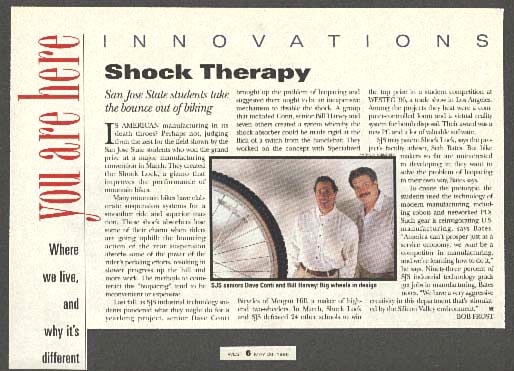
I was privileged to be a part of a fabulous teem of students that took the grand prize at this national competition. What is more, we were the smallest team (5 of us went to L.A. and went up against as many as 20 other engineering students), and the team with the least funding, (about $100 from the university and travel and lodging expenses paid for by the local chapter of SME (the Society of Manufacturing Engineers -thanks guys) -vs. a rumor of a budget of $40,000 from one of the other schools.
Morgan Hills Times June 22, 1999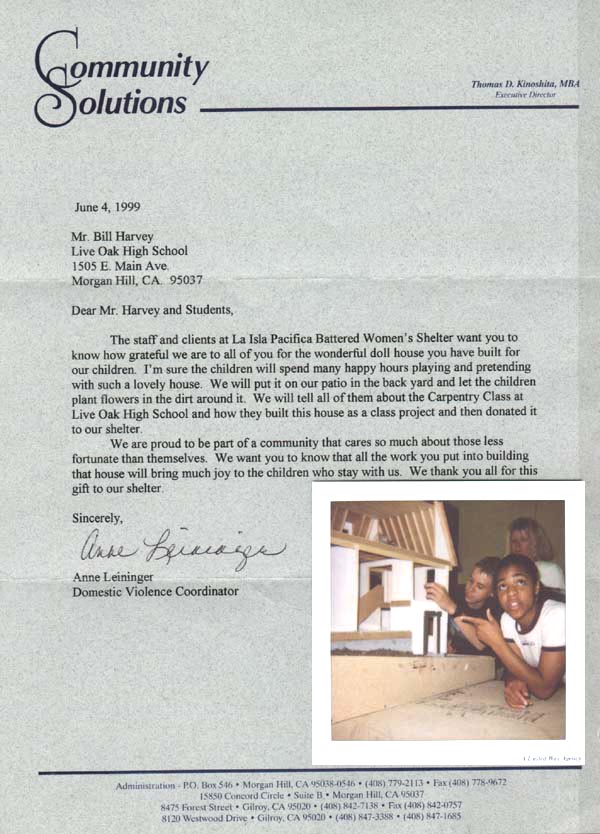
I taught an architecture class and in addition to the regular curricula, I
gave my students the opportunity to earn extra credit by doing work on a 1/12th
scale doll house. This particular project differed from the usual secondary
school model building projects in two ways: First, we started with a box of
dirt. We surveyed and leveled this dirt, excavated for the foundation (with a
spoon), formed and poured an actual concrete foundation.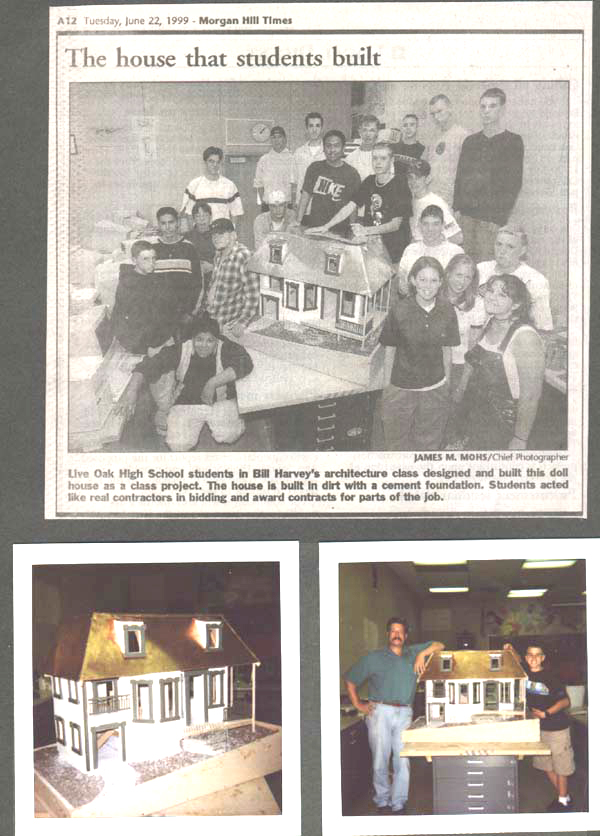
Second, while the students earned a number of points of extra credit for completing a given task, (and tasks that equated to the various trades and phases typical to residential construction), they had to "bid" to be awarded the contract. Generally, -but not always- the lowest bid won the contract. This bidding process became one of the classes favorite activities, and I was able to sneak a lot of information, planning skills, and real world pragmatism into the studentís thinking. Consider the above mentioned foundation. Two young women won the contract with a "bid" of 25 points of extra credit. (As the grades were to shake out, 25 points was to be the difference between an A and a C for instance.) They set the forms in the previously excavated hole and, -as would any good general contractor, I checked these forms before we poured concrete, and found them to be unacceptable. I suggested that they use some of their points and "hire an engineer." One of my best students, (from this and another class) was painstakingly meticulous about measurement and understood the idea of level very well. At my suggestion, they negotiated and decided among themselves that the girls would pay their "consulting engineer" 4 or 5 points for his help. The three of them then discovered that the excavation was off, so we called the "excavation contractor" back on the job to correct his work, and made him pay a point or two of his extra credit to the foundation contractors for having delayed the job. The girls then set the "re-bar", (straightened coat hangers), and hired another student for a few points to mix coffee cans of concrete for them as they poured, tamped, leveled etc. the concrete. (And dear me, it seems that dirty hands are just a dreadful crisis to young women of 15 to 17 years of age.) As a final note, they forgot to set J-bolts around the edge of the garage slab and neglected to cleanup after themselves one afternoon. Because it fell to the general contractor to fix and clean-up, the students learned about back-charges the hard way. When all was said and done, the girls earned a significant shot of extra credit, but not nearly as much as they thought they would. More to the point, they learned--and learned very well-- that God, AND the "profits" are in the details.
As the semester and construction progressed, some interesting dynamics developed quite aside from my input. For example, the students quickly began to recognize specialized talents in one another, and form quite effective teams. It was not uncommon for the extra credit points of a "contract" to be divided up between the student that originally won the contract and drew the plans, (and didnít get her hands dirty) and two other students that actually did the construction. They also came to own the whole project, (have a look at their faces in the newspaper clipping -the imperative to "be cool" notwithstanding), and became rather protective of their own work in particular. For example, the poor students that did the siding were supervised to the eníth degree by whichever student framed the wall they were currently siding.
My most recent work is in one of four "Customer's Scrapbooks" that show the casework, (drawer & display cases and a lot of coffee tables with windows), I've been doing for collectors and hobbyists.
The following has to do with the web site supporting to the work above. While some of it is about what it is about, it also has to do more with media and technique, -particularly web-friendly techniques.
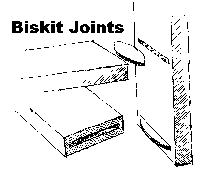
I do these quick small loose drawings when I need to illustrate an idea as well as punch-up a page of text. I like to scan as a bitmap at high resolution and high quality into Photoshop, where I do my scaling and down- sampling (this is actually 1" high -according to Photoshop) and add the caption -after the scaling is finished.
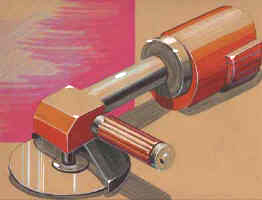
I find it useful to always have a purpose in mind for a given graphic. The above sketch -for example- pretends to be instructional, but it's purpose is really to provide decoration, -a short coffee-break for the eye amid a bunch of text. The Shock-Loc drawing serves -quite bluntly- to sell something, -sell an idea perhaps, but it provides no instruction and I make no bones about it's being 'art'.
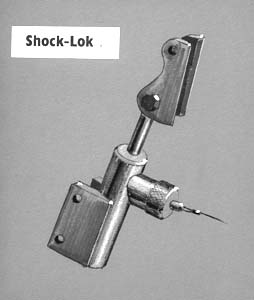
It is slightly more elaborate -a grayscale scan of a chalk and charcoal sketch on gray paper. This is perhaps my favorite media / technique and... -not to compare myself to the master without due humbleness- the technique Albrecht Durer mastered in the 15th century. What is particularly interesting about this sort of sketch is that it survives a scan at relatively low DPI. This drawing, for instance was scanned in grayscale at 75 dpi and comes in at 75k. Photoshop allows adjustments to contrast and brightness -and this makes this sort of drawing pop off the page (screen) with a minimum of fuss.
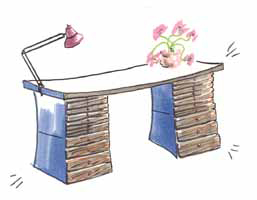
To give up detail in favor of a little color, I like these colorful cartoon-like drawings. This particular series is an example of that rather diabolical part of selling that is euphemistically offered as "ideas for your..." home / office / shop /etc.. The entire series of these drawings is available here.
Much of my drafting work has been for various clients and employers and proprietary in nature. As such, I can not show it here, (indeed, it lives on other computers.) What I can show here, however, is a series of AutoCAD drawings that compromise a study of the ergonomics of modular furniture installations. These are particularly interesting because they deal with organic -flowing curves of the human body, -not the sort of things that we tend to think of when we think of drafting. They are saved here in the form of PDF's, -a relatively new capability AutoDesk has added to AutoCAD 2000.
If you don't have Acrobat, -Adobe's PDF reader-, it is useful, free, and easy to download from Adobe's Web Site.
Return to HOME-MUSEUM HomePage